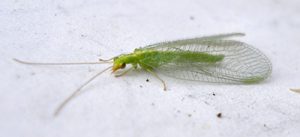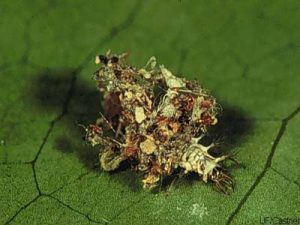I’m not sure about everyone else, but I have some favorite insects I encounter a lot around the garden. Most of these are ones that I see at work to help make the landscape work better such as pollinators and my favorites, the predators. One of the most interesting in this group is the lacewing and the peculiar behavior of some of their larvae.
Biology of the Lacewing
There are two major groups of lacewings in Florida: Brown and green. Both of them are excellent predators in the landscape, with their main target being aphids

. While green lacewing adults don’t feed on aphids, the brown lacewing does and both have predatory larvae. The adults lay eggs on landscape plants near aphid infestations. The eggs look like small eggs on the end of a silk strand, sticking outwards from the leaf. Once they hatch, they begin to eat. While doing so, they knock back populations of the plant-damaging aphids.
One cool fact about the green lacewing larvae is that it is often called a “trash bug” because of its practice of placing the emptied exoskeletons of its prey on its back. These pile up over time and seems pretty cool to me that this helpful critter shows off the work that its doing in the garden. Brown lacewing larvae eat aphids as well but don’t accumulate the trophies of their kills.
Protecting the Lacewing
I have gotten questions before about how to control these insects as they look something like pests and can even give a little pinch with their mouth parts if handled. In short, let them be and do some of your pest control for you.
To help attract lacewings, and other beneficial insects to your garden follow integrated pest management principles. In this system, look for issues at least weekly so

you can catch problems early and make sure you are identifying the problem correctly. If an issue is there, research the best method for control and try to limit pesticide usage to targeted, non broad spectrum products only when needed. This will limit the chances of your beneficial critters being knocked back as well. Also, remember these insects need food as well so some aphids in the landscape will attract and feed them, along with other predators such as lady beetles.
For more information on these awesome insects and Integrated Pest Management check out:
Brown Lacewings in Florida- UF/IFAS
Green Lacewings in Florida- UF/IFAS
Natural Enemies and Biological Control
 2
2
